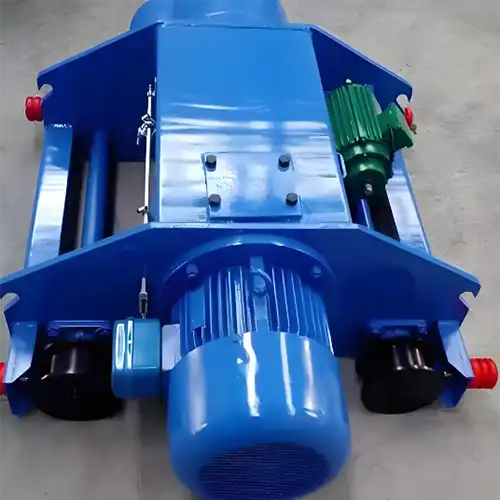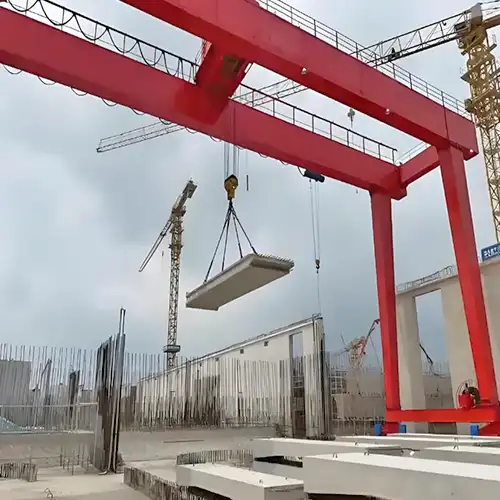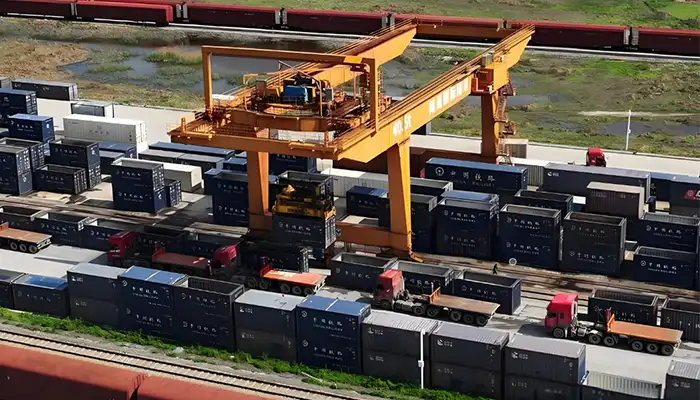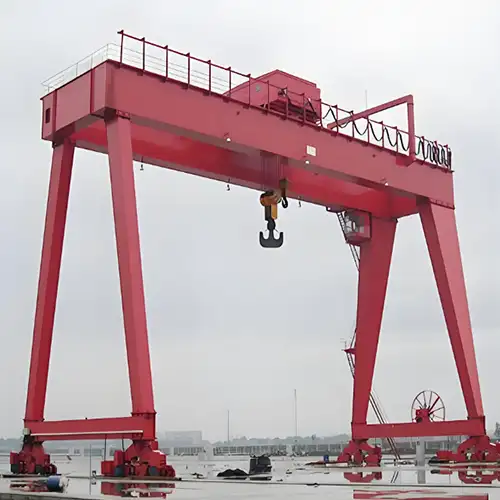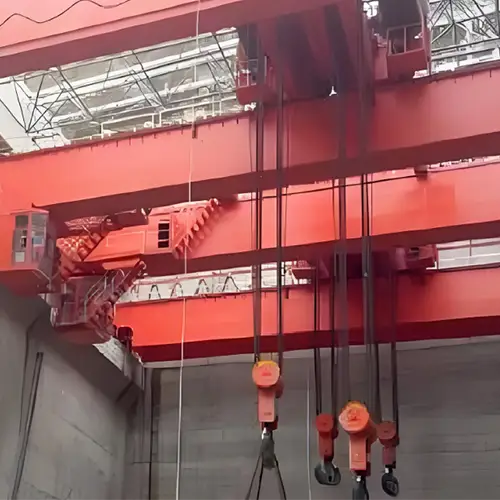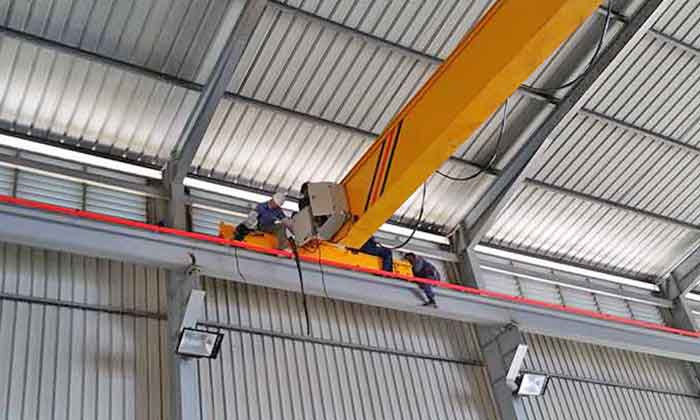
Crane Runway Rails for All Types of EOT Cranes & Crane Runways
EOTCRANEKIT offers a wide range of eot cranes, made of structural steel I-beams and manufactured box girders. Every eot crane is custom-built to meet the needs of our customers, with features that take full advantage of available space and deliver the optimum performance for each application.
Our eot cranes come in a variety of configurations, including top and under running, single and double girder, and roof mounted and free standing eot crane.
For you, this means that we can best match the eot crane to your company's brand preferences and the performance needs of your material handling applications because EOTCRANEKIT works with all of the leading eot crane and hoist component manufacturers.
Top Running EOT Cranes
- Top Running EOT Crane - Top running EOT Cranes are developed for low-headroom environments. The top running eot crane system travels above the runway on a fixed rail or track system, allowing the end trucks to transport the bridge and hoist along the runway's top. This gives the hook extra room between it and the ground. These eot crane systems can be set up in the following ways:
- Manual Overhead EOT Crane– A manual overhead EOT crane uses push/pull operations and is only utilized to hoist light weights.
- Single Girder Motorized EOT Crane– This is a single beam EOT crane that supports the trolley and is connected to the end trucks.
- EOT Crane with Two Girders– EOT Crane with two beams that run parallel along the eot crane runway.
Underrunning EOT Cranes
In general, underhung EOT Cranes are lighter and more versatile than top-running EOT Cranes. Underhung EOT Cranes are often mounted from the ceiling and are utilized for lighter applications. A monorail can also be utilized with interlocks and switches, and they can be set up to transfer a weight to an adjacent eot crane. These underhung crane systems can be set up in the following ways:- Manual Overhead EOT Crane– A Manual EOT Crane uses push/pull operations and is only utilized for lifting light weights.
- Single Girder Motorized EOT Crane– This is a single beam EOT crane that supports the trolley and is connected to the end trucks.
- EOT Crane with Double Girders– Two parallel beams that run the length of the eot crane runway.
Overhead eot crane Runway Configurations and Designs
EOTCRANEKIT offers freestanding, braced back, and ceiling mounted structural runway systems for top and underrunning EOT Cranes in a variety of configurations. Our runways are all made by qualified welders. Where building mounted runways are required, our team of eot crane experts will collaborate with your building supplier or engineer to give eot crane loading information.
There are a variety of overhead eot crane runway configurations to consider when supporting an overhead traveling EOT Crane to meet your operational requirements.Some of the variations are minor, but when the right configuration is recognized and chosen as part of your strategy, you'll have the most cost-effective and productive overhead handling system.Here's a quick rundown of what's available, as well as some things to consider so you can figure out what's ideal for you.
These runway designs can include, but are not limited to:
- Top running eot crane runway
- Under running eot crane runway
- Building supported / suspended runway
- Free standing structure with runway
- Semi-free standing structure with runway
Top running eot crane runway
These are most likely the most common in today's world. The main reason for this is that this crane design will result in the highest hook lift height possible within the given clear ceiling height in your building. On top of which the bridge end truck wheels travel is structural steel designed to accommodate either eot crane runway beams or alternative rail kinds, such as welded down square bars. This runway and eot crane combo has shown to be the most reliable and cost-effective to maintain.
Under running eot crane runway
Interlocking eot cranes that allow hoist trolleys to traverse from bridge to bridge or to monorail spurs are possible with this design. This allows the cargo to travel across the eot crane bays as well as the entire length of the runway, which is impossible with top-running eot cranes.
Note: These characteristics aren't inexpensive, so make sure you won't be able to meet your overhead load handling needs with alternative eot crane options. These runway beams, interlock crossovers, and spurs are typically suspended from and braced back to existing building steel, depending on the suspension mechanism. The runway sections can be manufactured from standard structural sections like I-beams and wide flange beams, or from unique track sections that are more function specific. Patented track sections can be stronger than structural parts over a given suspension span and wear out less quickly.
The new unique track components and aftermarket parts, on the other hand, will be more expensive, and the interlock and switch (spur) systems can be difficult to maintain and keep running properly and efficiently.
One final point to know about underrunning runways is that the runway beam splice alignment and allowed gap spacing are highly particular, regardless of which product and design you choose. Purchasing and installing runways as well as an eot crane will not be sufficient to create a viable and long-term solution.
Building supported / suspended runway
When you're developing a new structure and know you'll be buying overhead eot cranes, these runways are normally the preferred option. The most efficient technique to install eot cranes in your new facility is to have the structure support the eot crane runway steel. You will save floor space by not having to build additional upright columns with base plates that rest on the finish floor surface to support the runway beams, in addition to saving money.
The building steel is designed and constructed to support either top-running or under-running runway steel, as specified on your General Contractor's layout plans. Make sure you share these drawings with your eot crane supplier(s) so that everyone understands what is expected of them. This manner, you can avoid chargebacks and extended project completion timeframes.
Free standing structure with runway
Free standing overhead crane runways have become much more popular recently as many eot crane users are purchasing existing buildings/ facilities that did not previously have eot cranes in them. This is due to a surplus of real estate inventory, as well as the lower cost and faster time to occupancy for these properties compared to constructing a new facility from the ground up.
Top-running or under-running eot cranes can be supported by a free-standing structure. A completely independent runway does not require bracing to the existing structure and can bear all applied forces. These runways are also suitable for outdoor applications where no bracing is available. The eot crane and runway portions are supported by an extremely robust steel framework in the completely freestanding runway design. When the capacity or applied loads demand them, foundations are occasionally required beneath the structure's upright column base plates.
Semi-free standing structure with runway
This application is more cost-effective than the previous completely free-standing design, and it can accommodate both top- and bottom-running eot cranes. Moment connections between the columns and runway beams, as well as longitudinal stiffeners in specific bays throughout the runway length, are commonly used to stiffen semi-freestanding runways. The fact that the runway beams and columns brace back to the existing building steel is, however, the real key to this option's success. This reduces the amount of lateral stress that the runway construction will have to bear.This load influence back to the building is well within the design stresses for which the building is already constructed for most systems. Loads of 20 tons or less are frequently braced back to the building steel. Because the various applied loads are shared, semi-freestanding structures employ smaller steel sections than completely freestanding structures. With at least a 6" thick floor, the overturning moment of the column base plates is usually decreased enough to eliminate foundations. Both of these characteristics will result in significant project cost reductions. However, it is the buyer's responsibility to double-check all applied loads and permit the eot crane supplier to proceed with this runway structure.( More on Crane runway types and steel structures)
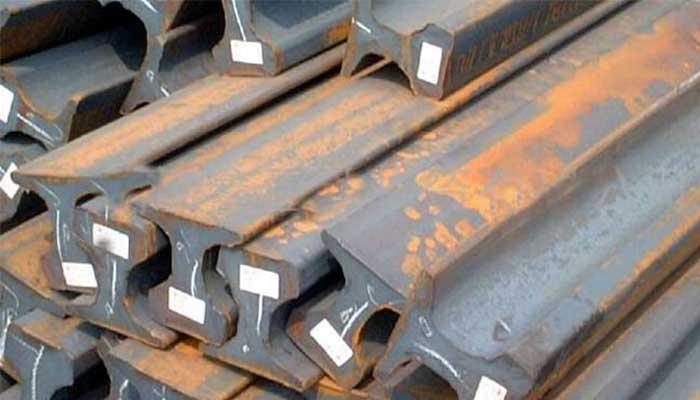
Types of eot crane runway beams
There are unique rails, rail tracks, square rails, and P-type tracks; square rails have a relatively high wear on the wheel and are now rarely used; P-type rails are frequently employed in eot cranes and trolleys.
The top of the rail is convex, the bottom is a particular width of plate, increasing the contact surface with the base; I-shaped track section with strong bending strength. Square steel can be seen as a flat-top rail, but because to tire wear, it's usually only used for lighter loads and slower speeds, so eot cranes aren't used very often. Carbon and manganese higher steels (C = 015 percent to 018 percent, Mn = 016 percent to 115 percent) are typically used to roll the rails. The eot crane runway beam is typically made of U71Mn steel. Q275 square steel or flat steel is the most common type of square steel.
Eot crane runway beams are used for eot cranes and trolleys with unique cross-section rails, with standard lengths of 9,915,10,1015,11,1115,12,1215 and 8 different types. The QU70, QU80, QU100, QU120, and QU behind the number of said track head width have common parameters. Heavy rail and light rail are the two types of railway rails, each with a nominal weight per meter length. Heavy rails have a weight per meter of greater than 30kg. Rail lengths of 12150m and specifications of 25100m2 are standard. Light rail usually has a length of 5 to 12 meters and weighs less than 30 kg per meter.
Low-alloy structural steels, such as Mn, Si, and P alloy elements, have been employed in recent years to improve the wear resistance and corrosion resistance of steel rails.
Eot crane runway beam dimension and eot crane runway beam specifications

P18 runway beam & rail - Overhead crane rail & gantry crane rail

P22 runway beam & rail - Overhead crane rail & gantry crane rail

P24 runway beam & rail - Overhead crane rail & gantry crane rail

P30 runway beam & rail - Overhead crane rail & gantry crane rail

P38 runway beam & rail - Overhead crane rail & gantry crane rail

P43 runway beam & rail - Overhead crane rail & gantry crane rail

QU80 runway beam & rail - Overhead crane rail & gantry crane rail

QU100 runway beam & rail - Overhead crane rail & gantry crane rail

QU120 runway beam & rail - Overhead crane rail & gantry crane rail
Features of well designed eot crane runway girders
A well-designed runway girder system should include the following features:
- sufficient overall strength to withstand the most unfavorable load combinations
- sufficient local/detail strength to withstand eccentric load application and torsion
- sufficient stiffness in both the vertical and lateral directions
- absence of brittle fractures or lamellar tears
- sufficient resistance to fatigue cracking
- a broad enough top flange to allow for rail clamp installation and lateral rail adjustment
- easy access for inspection and maintenance in the future.
In order to achieve the optimum overall solution, the structural designer and the eot crane manufacturer should collaborate. In practice, this rarely happens because eot crane runways are frequently constructed before the owner chooses an eot crane manufacturer and kind. It is also vital for the runway designer to get some understanding of the features of the various eot crane types, as well as to be familiar with eot crane operation, at least in the regions where the eot crane and the structure have a significant relationship.
The most critical interaction occurs in service at the intersection of the eot crane runway beam and the top flange, where many events take place:
- Variable vertical wheel loads are applied to the rail and dispersed throughout the girder web.
- The lateral wheel loads induced by inertial effects and the eot crane's oblique motion (meandering) are applied at the rail's top.
- Braking and accelerating forces are delivered to a bracing bay via the rail and girder.
- The rail absorbs dynamic loading and wear to protect the top flange from excessive wear and localized stressing.
- The structure of the building and the runways interact.
Types of eot crane runway beam s Installation Configuration
Eot crane runways beams are mainly installed in the following ways:

Configuration of crane runway beam & rail installation

Configuration of crane runway beam & rail installation

Configuration of crane runway beam & rail installation

Configuration of crane runway beam & rail installation

Configuration of crane runway beam & rail installation

Configuration of crane runway beam & rail installation

Configuration of crane runway beam & rail installation

Configuration of crane runway beam & rail installation
- For the work level M5 following the automobile track, utilizing continuous welding and a non-removable construction, the track section force can be included in the overall force of the main beam, increasing the main beam's bearing strength.
- b, diagram is the most widely used fixed approach, which is simple to assemble but more difficult to demolish.
- Working levels M6, M7, and M8 are covered by c and d.
- On the exceptional situations, e and f schematic using a screw connection for the bottom of the bolt is difficult.
- The g in the bottom of the track pad, which is 3-6mm thick rubber, can decrease the impact.
- h is the ring track fixation method.
- i is fixed on the eot crane runway beam carriage rail beam on the way.
More on How to Install Overhead eot Crane& Gantry eot Crane Runway Beam
Crane rail gnawing prevention for industrial eot crane safety
The gnawing of eot crane runway beams is a regular occurrence during the operation of an industrial eot crane. When rail gnawing occurs in industrial eot cranes, it can result in injury and a serious eot crane accident, both of which are extremely detrimental to the safety of your overhead and gantry eot cranes.
So, what exactly is the industrial eot crane runway rail gnawing?
The mutual friction between the wheel rim and the eot crane runway rail is referred to as rail gnawing. In most cases, there is a space between the wheel and the eot crane runway rail. They will not make contact while traveling. However, eot crane runway rail gnawing can occur when the eot crane wheel runs off track center.
Form of the crane rail gnawing
- So, what precisely is the gnawing of the industrial eot crane runway rail?
- Rail gnawing is the mutual friction between the wheel rim and the eot crane runway rail.
- Between the wheel and the eot crane runway rail, there is usually some space.
- When the eot crane wheel runs off track center, however, gnawing of the runway rail can occur.
Rail gnawing adverse consequences to industrial eot crane
- Reduce the wheel's service life ;Normally, a wheel's life span is 10 to 15 years, but for some industrial eot cranes with serious eot crane runway rail gnawing, the wheel's life span is only a year or a few months.
- Wear a tracksuit ;The track will be displaced because to the lateral force caused by rail nibbling.
- Increase the resistance to running.
- Increase the cost and increasing the motor load :Changes in plant loading circumstances have an impact on the safe use of industrial eot cranes.
- Derailment risk: In the event of severe rail-gnawing, wheels may climb up to the rail top, resulting in a derailment mishap.
The degree of rail gnawing
- Low level: "I" (first gear), controller starts slowly, a short distance after coasting brake.
- Middle level: "I," first gear, does not start,"II," second gear, starts slowly by the controller, no movement inertia when braking, rim has wear and tear.
- High level: "II," second gear, do not start, reverse operation within 10 meters, industrial eot crane body skewed peak, began to nibble rail
Rail gnawing causes analysis
- 1. The active wheels' diameters are too different.
- 2. The installation of four wheels in the wrong location, as illustrated in the diagram, D1>D2, or L2>L1.
- 3 The degree of wheel deflection error: the horizontal angle between the center line of the wheel tread surface and the center line of the track.
Rail gnawing discriminant standard
In general, wheel rim wear to the severity of the discriminant gnaw rail, flange wear is significant rail gnawing if it exceeds 1 mm, and needs to be repaired quickly.
Technical measures of avoid the rail gnawing
- 1 Reduce the diameter of the wheels: the active wheels' diameter should not exceed 0.2 percent of their base diameter, and the passive wheels' diameter should not exceed 0.5 percent of their base diameter.
- 2 Installation error adjustment: industrial eot crane diagonal and span of deviation shall not exceed 7mm, trolley diagonal and gauge deviation shall not exceed 3mm, and idiostatic of wheels shall not exceed 2mm.
- 3 The industrial eot crane traveling mechanism should be adjusted to the same tightness as the bearing and brake that are driving respectively. If the gear reducer and coupler, for example, have to be replaced, they should be done on both sides at the same time.
- 4 Tapered roller bearing clearance can be adjusted.Nominal bearing diameters (mm): 30-50, 50-80, 80-120,80-150, 120-200, 200-300 mm axial clearance(um)
From what has been explained above, which is manufacturing using our EOTCRANEKIT, different deviation detection indicated above are performed before leaving the plant to verify that the product is within the usual range. As a result, when a customer purchases our industrial eot crane, as long as the proper installation and routine maintenance are followed, rail gnawing will not occur.For more details on eot crane runway rail gnawing, please do not hesitate to contact us.
Eot crane & Runway Services
We offer turnkey eot crane runway solutions on a tailored basis. Every facility is distinct and necessitates meticulous planning to ensure the greatest level of craftsmanship.Runway extensions are a quick and easy method to make the most of your eot crane.Runway systems can also be updated to handle larger loads.
To maximize your return on investment, we focus on keeping simple and efficient designs.
- New construction, upgrades and modifications
- Footings and a rolled steel framework
Eot crane Modernization
Eot cranes typically have a long service life, which is beneficial because replacing one every few years would be prohibitively expensive and inefficient. While your outdated eot crane sits in your building, technology continues to advance year after year. When it comes to upgrading and modifying your eot crane, this is the time to do it. By modifying the eot crane runway, you may increase efficiency and productivity. If you're not sure where to change your eot crane, have a look at our quick guide below for some ideas.
Runway extensions
Expansion is frequently associated with growth. Your firm will determine whether this is a geographical or physical expansion. A physical expansion could indicate that you've expanded on to your facilities and now need a longer-range eot crane or hoist. Without purchasing a new eot crane, you can extend the runway of your existing eot crane to extend beyond the area where you've been operating. This is a fantastic approach to increase efficiency without incurring the costs of a second eot crane.
Reinforcement
You can't always lift heavier weights less frequently if your firm is growing and you need to be more efficient. Instead, you'll be living lots more frequently. You can counter this by strengthening your eot crane's payload capacity. An engineer will conduct a structural analysis as part of this procedure, which will aid in the creation of requirements particular to your eot crane. The adjustments you make will be determined by the type of eot crane you use and the amount of payload capacity you wish to improve.
Control systems
While your control systems will be on the ground, improving your control system will increase operation and efficiency on the runway. Improved responsiveness and new features will make your eot crane much more functional in general and give it a fresh, new look. These can also be updated to radio control units, which increase efficiency and production even more.
Upgraded girders
The girders of your eot crane are going to get a lot of use throughout the years. The hoist's continual back and forth will ultimately wear lanes through runners, and while this isn't an immediate problem, the steel will eventually corrode. You can replace your girders with more durable and sophisticated materials that will endure longer than the ones you now have.
Benefits of runway modification
If all goes well, your company will continue to expand. Your demands will change at some time, whether this growth is slow and steady or arrives in a burst. Modifying your eot crane is a wonderful method to ensure that it meets your demands without having to spend a lot of money on a new one every time your requirements change. When you update your eot crane to meet your demands, you can boost payload capacity, efficiency, and overall strength.
Eot crane Runway inspection and Maintenance
Full runway inspections and assessments are often an afterthought when EOT Crane and Hoist users desire to have world-class safety, operation, and condition evaluations performed on their eot cranes and hoists. This assumption is based on the idea that runways are static and will last for many years without requiring any maintenance or inspections. In fact, runways are dynamic and necessitate careful inspection and condition evaluation to ensure proper safety, trouble-free operation, and the longevity of both the eot crane and the runway rails.
Seasonal expansion and contraction strains on runways, columns, and fasteners are produced by temperature changes from cold in winter to hot in winter. When the runway is supported by the building structure and columns, as well as when the runway structure is independent and just tied back to the building, these stresses occur. The alignment of runways and columns, as well as the strains on runway tiebacks, are affected by expansion and contraction forces. Tiebacks are prone to breaking over time due to structural movement and vibration stresses caused by eot crane operation. Broken tiebacks result in runway alignment issues as well as increased strains on runway beams, which might lead to eot crane damage or structural failure.

Frictional pressures caused by EOT Cranes operating on the runways cause routine wear to the runway rail. Eot cranes that are poorly spanned or misaligned may cause rapid runway rail wear, which must be rectified soon in order to maintain the runway rail's proper working life. The cost of replacing large stretches of runway rail due to misaligned runways or EOT cranes is sometimes more than the cost of replacing the EOT cranes themselves. Vibration from eot crane operations loosens fasteners on runways, columns, the eot crane runway beam, and end stops. These unsecured fasteners frequently fall from ceiling level heights, posing a substantial risk of head injury to anyone working below.
To inspect a runway properly, the inspector must have access to visually and physically inspect both sides of the runway, as well as the columns and runway girders. If access to the runway is hampered by equipment on the floor or inventory, adequate fall protection measures must be provided above the runway beams to allow the inspector to safely walk the runway.
At least once a year, a thorough eot crane runway check should be performed, which should include the following.
- Check the whole length of the runway rail for abnormal or excessive wear on the head and sides.
- Look for loose hardware in each component of the rail fastening system.
- Examine the condition of runway splices and end stops, as well as their fasteners.
- Examine the condition of the end-stop bumpers.
- Examine the structural beams, columns, and shelves or haunches on the runway, as well as any attachment hardware.
- Inspect all runway tiebacks and associated hardware for wear and tear.
- Any structural bolts that have become loose must be replaced and torqued correctly according to AISC specifications.
- To determine the cause of excessive runway rail deterioration, a rail alignment and eot crane alignment survey should be conducted.
As you can undoubtedly see, a proper runway inspection cannot be completed in the time provided for a typical eot crane inspection and must be treated as a separate item that requires the appropriate amount of time based on access and runway length.
EOTCRANEKIT has fully competent Inspectors and runway assessment experts to ensure that your runway is safe and that the life and operation of your EOT Cranes and runway rail is maximized.
Qualified eot crane and hoist suppliers are used to working with tighter tolerances, so they'll make sure the runway beams they buy are from vendors that know what they're doing. They'll also take extra precautions to correctly shim the beams so that they're at the proper elevation. Although the cost may be slightly greater, the odds of experiencing runway troubles will be greatly reduced.
